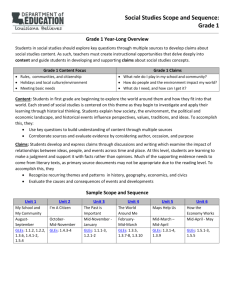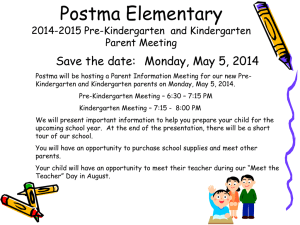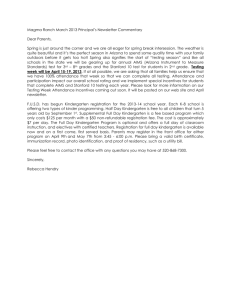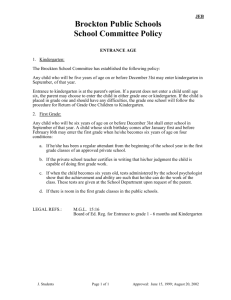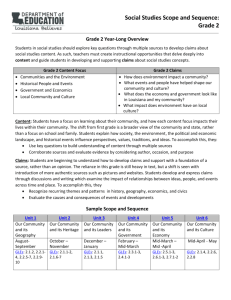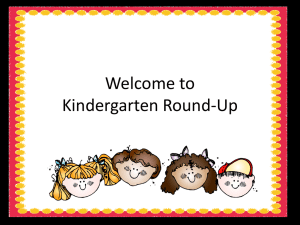Social Studies Sample Scope and Sequence
advertisement
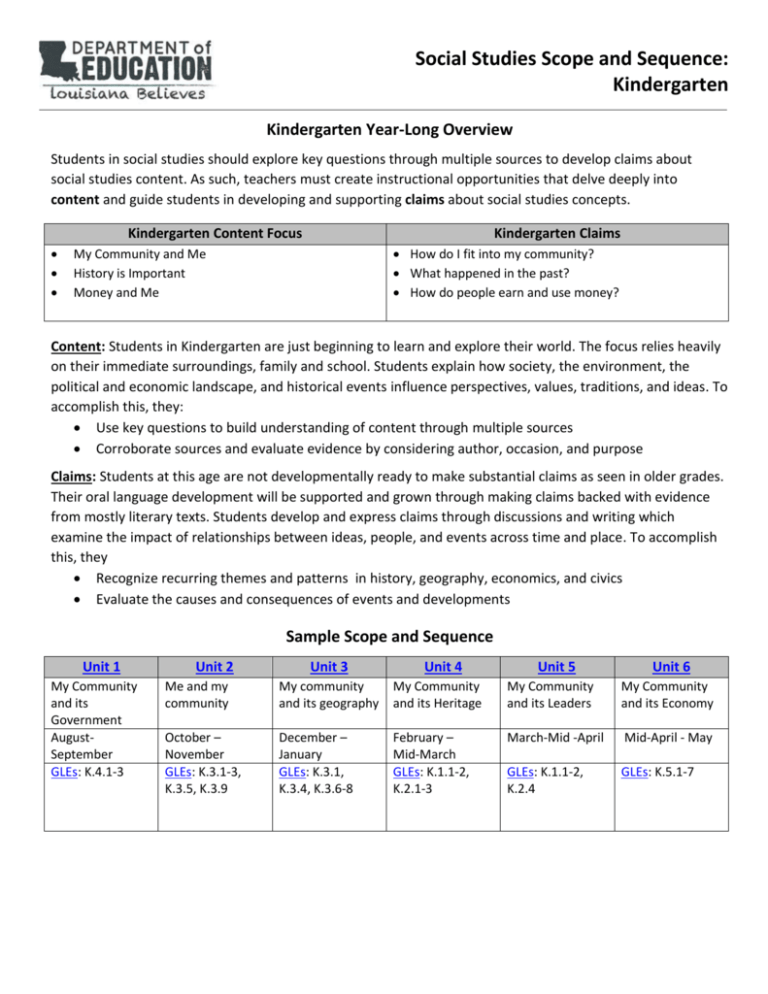
Social Studies Scope and Sequence: Kindergarten Kindergarten Year-Long Overview Students in social studies should explore key questions through multiple sources to develop claims about social studies content. As such, teachers must create instructional opportunities that delve deeply into content and guide students in developing and supporting claims about social studies concepts. Kindergarten Content Focus Kindergarten Claims How do I fit into my community? What happened in the past? How do people earn and use money? My Community and Me History is Important Money and Me Content: Students in Kindergarten are just beginning to learn and explore their world. The focus relies heavily on their immediate surroundings, family and school. Students explain how society, the environment, the political and economic landscape, and historical events influence perspectives, values, traditions, and ideas. To accomplish this, they: Use key questions to build understanding of content through multiple sources Corroborate sources and evaluate evidence by considering author, occasion, and purpose Claims: Students at this age are not developmentally ready to make substantial claims as seen in older grades. Their oral language development will be supported and grown through making claims backed with evidence from mostly literary texts. Students develop and express claims through discussions and writing which examine the impact of relationships between ideas, people, and events across time and place. To accomplish this, they Recognize recurring themes and patterns in history, geography, economics, and civics Evaluate the causes and consequences of events and developments Sample Scope and Sequence Unit 1 My Community and its Government AugustSeptember GLEs: K.4.1-3 Unit 2 Unit 3 Unit 4 Unit 5 Unit 6 Me and my community My community and its geography My Community and its Heritage My Community and its Leaders My Community and its Economy October – November GLEs: K.3.1-3, K.3.5, K.3.9 December – January GLEs: K.3.1, K.3.4, K.3.6-8 February – Mid-March GLEs: K.1.1-2, K.2.1-3 March-Mid -April Mid-April - May GLEs: K.1.1-2, K.2.4 GLEs: K.5.1-7 Social Studies Scope and Sequence: Kindergarten Unit 1: My Community and its Government (August–September) Unit overview: In this unit students will explore the role of an authority figure, and the relationship between rules and good citizens. This sets the stage for the unit to follow where students will explore their community and maps. Note: This content can be taught in conjunction with the Chrysanthemum unit (Lessons 2, 4 and 8) from the English Language Arts Guidebook for Kindergarten. Topic and Days Content and Claims People in Charge 15 days Good Citizenship 15 days Who are the people in authority within a family, school, and community? (K.4.1) How do authority figures help us? (K.4.1) What does an authority figure do? (K.4.1) Why are rules important at home, in class, and at school? (K.4.2) What are the roles, rights, and responsibilities of a good citizen? (K.4.3) Possible Sources Possible Sources No, David!, David Shannon David at School, David Shannon “A Community of People,” ReadWorks Possible Sources The Recess Queen, Alexis O’Neill “Jon Follows School Rules,” ReadWorks “Who is a Good Citizen at School?” ReadWorks Text from the ELA Guidebook Unit o Chrysanthemum, Kevin Henkes Social Studies Scope and Sequence: Kindergarten Unit 2: Me and My Community (October–November) Unit overview: In this unit students will explore maps and learn foundational map skills. This sets the stage for the unit to follow where students will apply map skills and learn about the ways people live in various areas. Topic and Days Content and Claims Map Skills What is a map? (K.3.2, K.3.3) How can maps help us? (K.3.5, K.3.9) Where do I live? (K.3.1, K.3.9) How can I tell about places in my school and community? (K.3.1, K.3.3) 20 days My Community on a Map 15 days Possible Sources Possible Sources Can You Read a Map, Rozanne Lanczak Williams Maps, Maps, Maps, Joan Chapman Rosen My Map Book, Sara Fanelli Types of Land, Harcourt Follow That Map! A First Book of Mapping Skills, Scot Ritchie Possible Sources Me on the Map, Joan Sweeny Where do I live?, Neil Chesanow Social Studies Scope and Sequence: Kindergarten Unit 3: My Community and its Geography (December–January) Unit overview: In this unit students will explore how the landscape and weather affects the lives of people in various areas. This sets the stage for the unit to follow where students will explore the past, including how life was different and important events that helped to shape the country. Note: This content could be taught in conjunction with the Year at Maple Hill Farm unit (Lessons 1, 3, 4, 5, 6 and 7) and Cloudy with a Chance of Meatballs unit (Lessons 1, 6 and 7) from the English Language Arts Guidebook for Kindergarten. Topic and Days Content and Claims Mapping Resources 10 days Different Lifestyles 20 days Possible Sources How can we describe the location of objects compared to others? (K.3.1, K.3.4) How can we classify our natural resources? (K.3.8) Possible Sources Rosie’s Walk, Pat Hutchins “Some Trees Give us Food,” ReadWorks How does weather affect daily choices? (K.3.6) How do people in various places live differently? (K.3.7, K.3.4) Possible Sources “City Life and Country Life,” ReadWorks The Country Mouse and City Mouse “A Hurricane is a Big Storm,” ReadWorks Types of communities, Professor Garfield Interactive Site Texts from the ELA Guidebook Units (Farm, Cloudy ) o The Year at Maple Hill Farm, Provensen o The Wind Blew, Pat Hutchins o “Change Is in the Air,” National Geographic Young Explorer, March 2012, pages 11-15 o “The Weather Outside,” National Geographic Young Explorer, September 2011, pages 18-23 Social Studies Scope and Sequence: Kindergarten Unit 4: My Community and its Heritage (February–Mid-March) Unit overview: In this unit students will explore the past, including how life was different and important events that helped to shape the country. This sets the stage for the unit to follow where students will explore influential leaders and their influence on history. Note: This content could be taught in conjunction with the A is for America unit (Lessons 1, 3, 4, 5, 6, 7, and 9) from the English Language Arts Guidebook for Kindergarten. Topic and Days Content and Claims Then and Now 15 days Holidays and Symbols 15 days Possible Sources How do we measure time? (K.1.2, K.2.1) How can I describe events in a correct sequence? (K.1.1) How are children and families today both the same and different from those in the past? (K.2.1) Possible Sources “Getting Water from a Well,” Readworks What Time is it, Mr. Crocodile?, Judy Sierra Communities: Then (Pictures from The Louisiana Digital Library) o Covered wagon used as school bus in LaSalle Parish 1920 o Class picture 1921, Livingston Elementary What are some important local, state, and national symbols? (K.2.2) What are some celebrations, holidays, and events and why are they important? (K.2.3) Possible Sources The Sound of Day, The Sound of Night, Mary O’Neil Seasons of the Year, Margaret Hall “The United States of America,” ReadWorks “The Liberty Bell,” ReadWorks “America the Beautiful” (audio) Texts from the ELA Guidebook Unit o “The Home of the President: Washington, D.C.” from Domain 12 of the Grade K Core Knowledge Listening and Learning Strand Read Aloud Anthology (Pages 14- 17) o A is for America by Devin Scillian Social Studies Scope and Sequence: Kindergarten Unit 5: My Community and its Leaders (Mid-March–Mid-April) Unit overview: In this unit students will explore key historical people and their actions that have made lasting impacts on the country. This sets the stage for the unit to follow where students will explore foundational economic skills related to their lives. Note: This content could be taught in conjunction with the A is for America unit (Lessons 3, 4, 5, 6, 7, 8, and 9) from the English Language Arts Guidebook for Kindergarten. Topic and Days Content and Claims Important Leaders 20 days Who are some important people from history? (K.2.4) How have these people influenced history? (K.2.4) Sample Tasks and Possible Sources Possible Sources “Edison Tried and Tried Again,” ReadWorks “Squanto was a helper,” ReadWorks “Ben Franklin’s Idea,” ReadWorks “George Washington’s Cherry Tree,” ReadWorks Life of George Washington, Scholastic video Texts from the ELA Guidebook Unit o Grade K Core Knowledge Listening and Learning Strand Read-Aloud Anthology: o “George Washington” (pages 48-51) o “Thomas Jefferson” (pages 58-61) o “Abraham Lincoln” (pages 75-78) o A is for America, Devin Scillian Social Studies Scope and Sequence: Kindergarten Unit 6: My Community and Its Economy (Mid-April–May) Unit overview: In this unit students will explore foundational economics as it applies to their lives. This final unit sets the stage for first grade to follow where students further develop all skills in more depth and detail. Topic and Days Wants and needs 10 days Money and Jobs 10 days Content and Claims What are wants and basic needs? (K.5.1) How does scarcity impact us in the classroom? (K.5.3) What are goods and services and how do we get them? (K.5.4, K.5.6, K.5.7) How do people earn and save money? (K.5.2, K.5.5) Sample Tasks and Possible Sources Possible Sources Berenstain Bears Get the Gimmies, Stan and Jan Berenstain Ant and Grasshopper (audio only), Finance in the Classroom Ant and the Grasshopper , Youtube “Ant and Grasshopper,” Readworks Music Connection, Finance in the Classroom Possible Sources Little Critter: Just Saving My Money (My First I can Read), Mercer Mayer Clothesline Clues to Jobs People Do , Heling and Hembrook A Day in the Life of a ___ (Community Helpers at Work), First Facts Bear About Town, Stella Blackstone A Visit to a Construction Site (video) Mr. Rogers’ Neighborhood Save, Spend, and Share, Sesame Street o Elmo’s Saving Jar o How Do People Get Money? o Learning to Save 2011 Social Studies Grade-Level Expectations: Kindergarten Standard 1 – Chronological Thinking Skills Students apply a sense of time in daily routines within their community. K.1.1 Order events that take place in a sequence using appropriate vocabulary K.1.2 Describe the function of tools used for representing time Standard 2 – Historical Thinking Skills Students distinguish between events, people, and symbols in the past and present. K.2.1 Compare and contrast children and families of today with those in the past using various sources K.2.2 Identify symbols of local, state, and national importance using various sources K.2.3 Identify local, state, and national celebrations, holidays, and events using various sources K.2.4 Recall facts about people of the past and present Standard 3 – Maps, Globes, and Environment Students demonstrate an understanding of the connections between their physical and cultural environments through the use of globes, maps, and other visual representations. K.3.1 Demonstrate an understanding of the relative locations of objects through the use of appropriate vocabulary K.3.2 Identify maps and globes as a representation of the earth and recognize the difference between land and water K.3.3 Demonstrate geographic knowledge of places within the school and community K.3.4 Illustrate basic landforms K.3.5 Construct maps of familiar locations K.3.6 Describe how weather affects daily choices K.3.7 Describe how people live differently in other places using various sources K.3.8 Identify natural resources as being renewable/non-renewable or recyclable K.3.9 Demonstrate spatial understanding that students are a part of (i.e., classroom, school, town/city, and state) Standard 4 – Government and Citizenship Students understand how to participate and use effective citizenship skills at home, in school, and in the community. K.4.1 Identify individuals in a position of authority within a family, school, or community and their responsibilities K.4.2 Explain the importance of rules at home, class, and school K.4.3 Discuss the roles, rights, and responsibilities of being a good citizen in a family, class, and school 2011 Social Studies Grade-Level Expectations: Kindergarten Standard 5 – Basic Economic Concepts Students develop an understanding of economic concepts and develop decision-making skills. K.5.1 Identify wants and basic needs K.5.2 Explore the concept of saving K.5.3 Discuss the concept of scarcity within classroom situations K.5.4 Explore concepts of goods/services K.5.5 Describe jobs that people do to earn money K.5.6 Explain how products get from a point of origin to consumers K.5.7 Describe a voluntary exchange/trade


